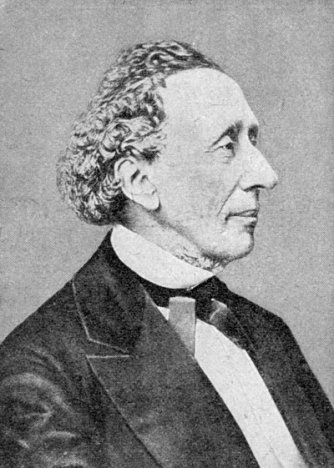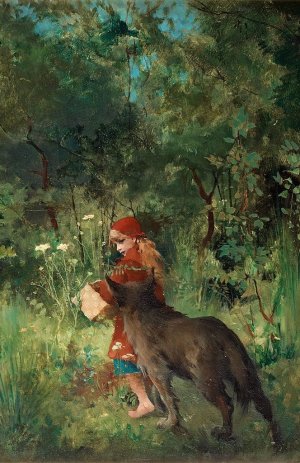| Library / Literary Works |
Biography of Hans Christian Andersen

Hans Christian Andersen, also known as simply H. C. Andersen (April 2, 1805 – August 4, 1875) was a Danish author and poet, most famous for his fairy tales. Among his best-known stories are "The Steadfast Tin Soldier", "The Snow Queen", "The Little Mermaid", "Thumbelina", "The Little Match Girl", "The Ugly Duckling" and "The Red Shoes".
During Andersen's lifetime he was feted by royalty and acclaimed for having brought great enjoyment to a whole generation of children throughout Europe. His fairy tales have been translated into more than 150 languages and they continue to be published in millions of copies all over the world.
Childhood
Hans Christian Andersen was born in the town of Odense, Denmark, on Tuesday, April 2, 1805. Most English (as well as German and French) sources often refer to his name as "Hans Christian Andersen". However, in Denmark and in the other Nordic countries he is usually known as "H. C. Andersen". His first name "Hans Christian" consists of two old, traditional Danish names pronounced as a single name. The combination of two individual names being spoken without a pause between the words is really not all that common in the Danish language.
H.C. Andersen's father was of the belief, that he was related to nobility. According to scholars at the Hans Christian Andersen Center, the paternal grandmother had told Andersen's father, that their family in the past had belonged to a higher social class. However, later investigations proved that these stories were unfounded indeed. Their family apparently did have some connections to the Danish royalty, but they were only related to the subject of employment or trade.
Nevertheless, the speculations that H.C. Andersen was the illegitimate son of one of members of the royal family continues to persist in Denmark today. These speculations have been bolstered by the fact, that the Danish king at Andersen's time did take a personal interest in H.C. Andersen as a young man. The king had for example paid for a part of Andersen's education.
Andersen displayed great intelligence and imagination already as a young boy, qualities that were reinforced by the indulging parents and emphasized by the superstition of his mother.
As a child he built himself a small-scale puppet theater. He made clothes for all his puppets. He read as many plays as he could lay his hands on. Many of these plays were the plays of Ludvig Holberg (Danish writer and poet) and those of William Shakespeare. Throughout his childhood he had a passionate love for literature. He was known to be able to memorize entire plays by Shakespeare and to recite these plays while using his wooden puppets as actors in the plays.
In 1816, his father died because of an illness he obtained soon after leaving the family for the war against Sweden and, in order to support himself, Andersen worked as an apprentice for both a weaver and a tailor. At the age of fourteen, Andersen moved to Copenhagen seeking employment as an actor in the theatre. He had a pleasant soprano voice and succeeded in being admitted to the Royal Danish Theatre. This career stopped short when his voice broke. A colleague at the theatre had referred to him as a poet, and Andersen took this very seriously and began to focus on writing.
Following an accidental meeting, Jonas Collin started taking an interest in the odd boy and sent Andersen to the grammar school in Slagelse, paying all his expenses. Before being admitted to grammar-school, Andersen had succeeded in publishing his first story, The Ghost at Palnatoke's Grave in 1822.
Early works
In 1829, Andersen enjoyed a considerable success with a short story entitled "A Journey on Foot from Holmen's Canal to the East Point of Amager". He had little further progress, however, until 1833 when he received a small traveling grant from the King, making the first of his long European journeys. At Le Locle, in the Jura, he wrote "Agnete and the Merman"; in 1833 he visited the Italian seaside village of Sestri Levante; and in October 1834 he arrived in Rome. Andersen's first novel, The Improvisatore, was published in the beginning of 1835, and became an instant success.
Andersen's Fairy Tales
It was during 1835 that Andersen published the first installment of his immortal Fairy Tales (Danish: Eventyr). More stories, completing the first volume, were published in 1836 and 1837. The quality of these stories was not immediately recognised, and they sold poorly. At the same time, Andersen enjoyed more success with two novels: O.T. (1836) and Only a Fiddler. His Specialty book that is still known today was the Ugly Duckling. (1837).
Jeg er en Skandinav
After a visit to Sweden in 1837, Andersen became inspired by Scandinavism and committed himself to writing a poem to convey his feeling of relatedness between the Swedes, the Danes and the Norwegians. It was in July 1839 during a visit to the island of Funen that Andersen first wrote the text of his poem Jeg er en Skandinav (I am a Scandinavian). Andersen designed the poem to capture "the beauty of the Nordic spirit, the way the three sister nations have gradually grown together" as part of a Scandinavian national anthem. Composer Otto Lindblad set the poem to music and the composition was published in January 1840. Its popularity peaked in 1845, after which it was seldom sung.
Travelogues
In 1851, he published to wide acclaim In Sweden, a volume of travel sketches. A keen traveller, Andersen published several other long travelogues: Shadow Pictures of a Journey to the Harz, Swiss Saxony, etc. etc. in the Summer of 1831 (A Poet's Bazaar (560), In Spain , and A Visit to Portugal in 1866 (The latter describes his visit with his Portuguese friends Jorge and Jose O'Neill, who were his fellows in the mid 1820s while living in Copenhagen.)
In his travelogues, Andersen took heed of some of the contemporary conventions about travel writing; but always developed the genre to suit his own purposes. Each of his travelogues combines documentary and descriptive accounts of the sights he saw with more philosophical excurses on topics such as being an author, immortality, and the nature of fiction in the literary travel report. Some of the travelogues, such as In Sweden, even contain fairy-tales.
The fame of his Fairy Tales had grown steadily; a second series began in 1838 and a third in 1845. Andersen was now celebrated throughout Europe, although his native Denmark still showed some resistance to his pretensions.
Meetings with Dickens
In June 1847, Andersen paid his first visit to England and enjoyed a triumphal social success during the summer. The Countess of Blessington invited him to her parties where intellectual and famous people could meet, and it was at one party that he met Charles Dickens for the first time. They shook hands and walked to the veranda which was of much joy to Andersen. He wrote in his diary "We had come to the veranda, I was so happy to see and speak to England's now living writer, whom I love the most."
Ten years later, Andersen visited England, primarily to visit Dickens. He stayed at Dickens' home for five weeks, oblivious to Dickens' increasingly blatant hints for him to leave. Dickens' daughter said of Andersen, "He was a bony bore, and stayed on and on." Shortly after Andersen left, Dickens published David Copperfield, featuring the obsequious Uriah Heep, who is said to have been modeled on Andersen. Andersen himself greatly enjoyed the visit, and never understood why Dickens stopped answering his letters.
Death
In the spring of 1872, Andersen fell out of bed and was severely hurt. He never quite recovered, but he lived until August 4 1875, dying quietly in a house called Rolighed (literally: calmness), near Copenhagen, the home of his close friends Moritz Melchior, a banker, and his wife. Shortly before his death, he had consulted a composer about the music for his funeral, saying: "Most of the people who will walk after me will be children, so make the beat keep time with little steps."
Legacy
In the English-speaking world, stories such as "Thumbelina", "The Snow Queen", "The Ugly Duckling", "The Little Mermaid", "The Emperor's New Clothes", and "The Princess and the Pea" remain popular and are widely read. "The emperor's new clothes" and "ugly duckling" have both passed into the English language as well-known expressions.
Source: Wikipedia

